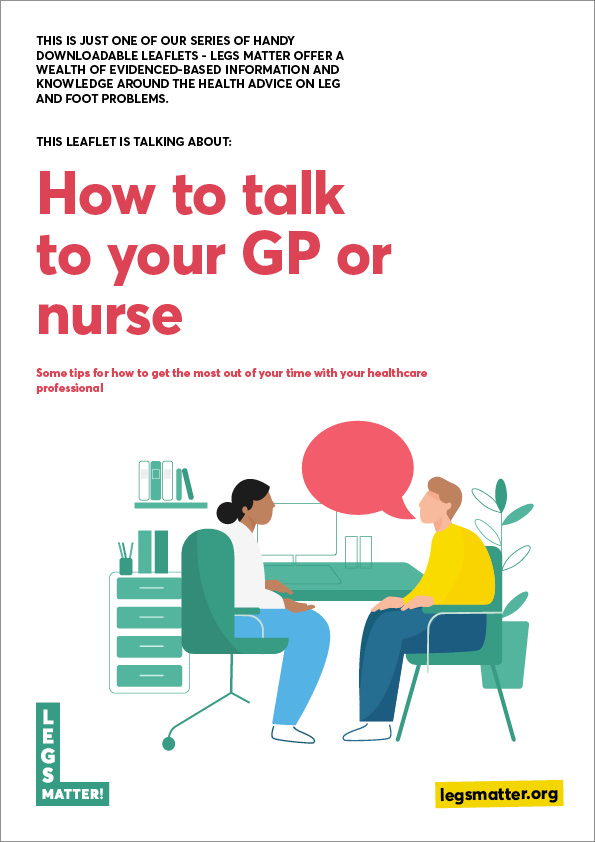Here are our tips for how to get the most out of your time with your GP, nurse, or other healthcare professional:
- Be honest and open: Your doctor or nurse can’t help you if they don’t know what’s going on. Be honest about your symptoms, concerns, lifestyle (including exercise, smoking and alcohol consumption) and any treatments you’ve already tried.
- Ask questions: Don’t be afraid to ask questions if you don’t understand something. Your doctor or nurse is there to help you, and they want you to be informed. See our suggestions below for the questions that everyone who has a leg or foot condition should ask their GP or other healthcare professional.
- Bring a list: If you have a lot of questions or concerns, consider making a list before your appointment. This will help you stay organised and ensure that you don’t forget anything important.
- Bring a log of your symptoms: Including pain levels, any triggers and if symptoms have worsened for example, if your leg ulcer has increased in size.
- Take a friend or family member: If you’re feeling anxious or worried about talking about your leg or foot problem, consider bringing a friend or family member with you for support. This can help you feel more comfortable and provide an extra set of ears for the conversation.
Questions to ask your GP or other healthcare professional about your legs and feet
“What are my treatment options?”
Talking to your clinician about your treatment options and choices can feel empowering as you work in partnership to decide on the best course of treatment tailored to your individual needs.
“Do I need to be referred to a specialist to get a diagnosis in order to access the right treatment(s)?”
Getting a diagnosis can be the first step in finding the right course of treatment. To get a diagnosis you may need to be referred to a different specialist.
“Are there any lifestyle changes that you feel I should make to better manage my condition(s)?”
Taking ownership of your own health when this is possible can make all the difference. This could be changes in diet, increasing movement or even finding ways to manage health anxiety.
“What are the risks associated with my condition(s)?”
It’s really important to understand the risks that your health condition(s) present so that you are empowered with the right knowledge and understand why particular treatments, such as compression therapy, is so important. If you have a better understanding of what could happen in the longer term this may help to motivate you in sticking to a treatment plan or making certain lifestyle changes that can improve your overall health outcomes.
“Are there any resources or organisations that you’d recommend?”
Your clinician may be able to signpost you to relevant charities or professional organisations where you can find out more information and the latest treatments or clinical guidance available. They may also be able to put you in touch with a local community group so that you can connect with other patients and share self-management tips. Information is power!
“What types of compression would work best for me and are there options to consider?”
There are many different types of compression available and suppliers work to advance the technology and materials used and so treatment options are constantly evolving. If you are prescribed compression therapy, your clinician may recommend a certain type of material, such as a flat knit rather than circular knit, but it’s important that you understand the differences. You may find that a different type of compression like a wrap or layered bandaging is advised instead. Treatment options should always be decided in partnership with you and your clinician – you know your body and symptoms best.
“How can I best manage my pain and how can I escalate treatment if my pain increases?”
Many patients experience pain as a result of their condition(s) and need ongoing support in managing this. What may work for a time may stop working, or your condition may change and so it’s important to talk through the options available to you. It’s reassuring to know that you can talk to someone if your pain does increase.
“How often can I expect appointments / regular check-ups? Is there any flexibility in frequency and location?”
It’s good to know how often you can expect an appointment and when to call up to book in as many clinics have a wait list. For some conditions, such as a leg ulcer, frequent appointments to change dressings may be required and flexibility in the time or location of appointments can make all the difference, particularly for those with caring, work or other commitments.
How to talk to your GP or nurse downloadable leaflet (PDF)
We’ve created a handy downloadable leaflet of the key information on this page so you can easily print it out for personal reference or to hand to a patient or healthcare professional. Or you can also simply forward it on by email.










